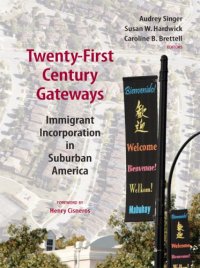
Ebook: Twenty-First Century Gateways: Immigrant Incorporation in Suburban America
- Series: James a. Johnson Metro Series
- Year: 2008
- Publisher: Brookings Institution Press
- Language: English
- pdf
As the twentieth century came to a close, the United States experienced an extraordinary transformation of its population. More immigrants, both legal and undocumented, arrived during the decade of the 1990s than in any other decade on record. While immigrants continued to flow into traditional gateways such as New York, Chicago, and Los Angeles, even faster growth occurred in unexpected new locations with no history of immigration —places such as Atlanta, Charlotte, and Dallas-Ft. Worth. T wenty-First Century Gateways focuses on the fastest-growing immigrant populations among ''second-tier'' metropolitan areas including Atlanta, Austin, Charlotte, Dallas, Minneapolis-St. Paul, Phoenix, Portland, Sacramento, and Washington DC. Today one in five immigrants in the United States lives in a twenty-first-century gateway. These metropolitan areas are characterized by post-WWII urban development and growth, recent burgeoning immigrant populations, and predominantly suburban settlement. Written by an interdisciplinary group of experts, Twenty-First Century Gateways provides in-depth, comparative analysis of immigration trends and local policy responses in America's newest gateways. The case examples explore the challenges of newcomer integration in those gateways, as well as immigration's impact on suburban infrastructure such as housing, transportation, schools, health care, economic development, and public safety. The changes wrought by these new suburban settlement patterns have remained largely unexamined until now. Yet they have been critically important in reshaping the United States of today and understanding the future of the impact of immigration. The new trends dissected in this important book present a new context for the social, economic, and political incorporation of the newest Americans.